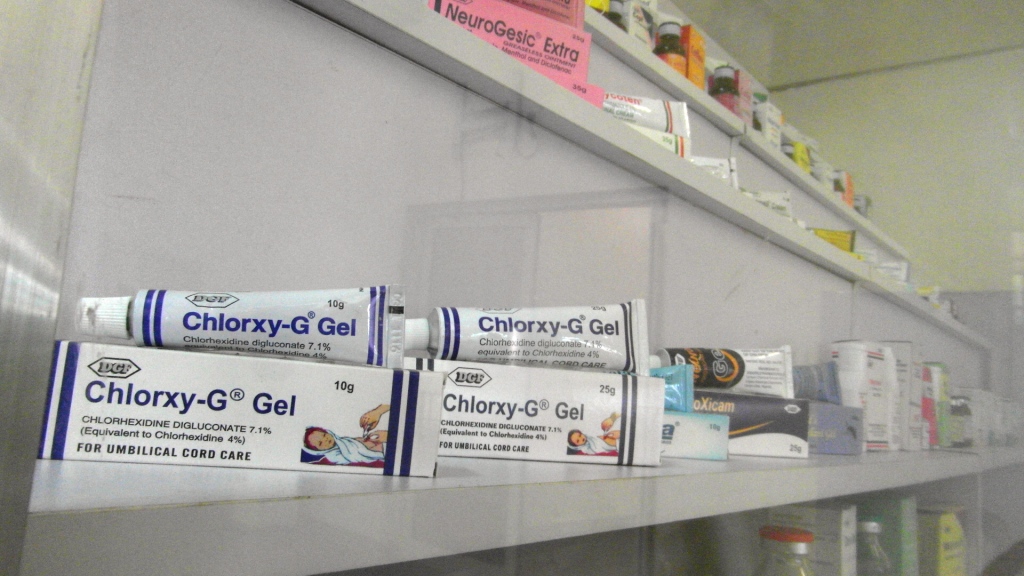Production is up for chlorhexidine, a gel to prevent infection in newborns.
The target is to stop 55,000 newborn deaths by 2020 and supply the West African market.
But babies aren’t even getting the gel
On a massive complex in Sango-Otta, Ogun state, a huge operation is underway. The complex generates its own power, for both heating and cooling.
A line pipes distilled water into a vat inside. An air lock leads into its warehouse. Pressure and sterility is under tight control: only one door can open at a time. Two doors open at a time lets off an alarm.
In the warehouse are batches of guar gum and chlorhexidine digluconate. Both join the distilled water in the vat inside a processing room to make a gel. The gel sits for hours and must pass quality control before the next step.
In a filling room, a worker in green surgical wear and mask sorts empty tubes onto a line. A mechanical sorter guides the tubes top-down onto a rotating hold. One by one, the tubes come under a press. A dollop of 7.1% chlorhexidine digluconate gel is squeezed in. Another robot seals the end. The tube is ready—25,000 of them in a single production batch.
Each tube is bound for the umbilical cord of a baby somewhere in Nigeria, and will deliver 4% chlorhexidine (CHX) on each daily application until the stump of the baby’s umbilical cord falls off.
At least, that’s what is supposed to happen. But it isn’t.

The complex has capacity to produce 63 million tubes of CHX a year. In practice, it produces just under five million. At least six million babies are born every year in Nigeria, but parents and caregivers aren’t just bothered using CHX for cord care.
The complex run by the pharmaceutical firm Drug Field is among four firms that have received backing to venture into CHX production.
They could potentially supply the entire West Africa region. Health officials from nine francophone countries toured the entire CHX production line at Drug Field to assess supply and capacity for good manufacturing practice.
Their assessment could spark use of chlorhexidine and spark orders in Mali, Niger, Cote d’Ivoire, Senegal, Guinea, Burkina Faso, Benin, Togo and Mauritania. It could also force Nigeria to rejig its own nationwide scale up of chlorhexidine for cord care.
Years of research from Bangladesh and Nepal back the introduction of chlorhexidine for cord care in Nigeria. For every 1,000 children born, 37 die before they are 28 days old. One in four of those neonatal deaths in 2016 were from preventable infections, many of which can be averted by proper care of the umbilical cord.
All needed was a swab of CHX gel a day. It has been found to reduce neonatal deaths by 23%.
A project piloted its use in Bauchi and Sokoto in 2012, paving way for the country to officially launch it and develop strategy to implement CHX use nationwide in 2016.
The strategy targets health facilities as the easiest way to reach newborns through mothers. It also encounters a long-running problem in Nigeria. Only around 35 in 100 births occur in a health facility, the rest are at home. According to Bose Adeniran, director of child health at the federal health ministry. The challenge is to ensure up to 80 in 100 births take place in hospital.
If the strategy goes well, two year from 2016, at least 15 in every 100 newborns should get cord care with CHX. The proportion is expected to triple in five years to 52% of newborns, averting nearly 55,000 deaths.
But two years into scale-up of CHX, less than five in 100 newborns get cord care with CHX.
“We are looking at how we can double our gains to get more newborns saved at birth,” says Dr Olayinka Umar-Farouk, senior newborn health specialist with the Maternal and Child Survival Programme, a US-funded project to support CHX scaleup.
“The missing link generally is the awareness. The demand drive has not been efficient. Nothing has been done in creating awareness. What we have been able to do is have a policy, disseminate it. So if the woman is not aware and the policy makers are aware, you have not reached the critical mass because these are the people that will apply the gel to the newborn.”

For long, health workers and caregivers have used methylated spirit in cord care. Outside of hospitals, caregivers have used dung, toothpaste, shea butter, the knowledge has been passed down through generations of mothers.
The launch of CHX strategy in 2016 prompted a shakeup to remodel essential newborn care to include use of CHX for cord care and infuse it into basic training for health workers.
“It has been going on in phases. You can’t do a mass training. That’s among the issues making the progress not to have reached critical mass. Awareness drive is still very low,” says Umar-Farouk.
By March this year, 37 states have developed any plan to scale up CHX use, 31 updated their essential medicine list to include CHX—and make it available for primary health care. But only 29 states have put CHX into their five-year strategic health development plan expected to be reviewed by 2022. But only 24 states have initiated any sensitization for CHX.
Sustaining the use of chlorhexidine is beyond the benefits research show. It has since been classed as an over-the-counter product, making it available in drug stores.
Averting 55,000 newborn deaths in five years means investing to ensure CHX is present in the delivery kits mothers get in hospitals, or in packs used for home delivery.
Last year, 19 states procured it with state budget or funds from the Saving One Million Lives programme. Donors and nongovernment organisations paid for CHX in nine others state. Nine states did procure any chlorhexidine.
MCSP supported 121 health facilities in Kogi in efforts to prove having CHX readily available and making healthworkers aware of it encouraged them to use.
Among 109 facilities that kept data, the proportion of newborns receiving their first CHX swab in hospital rose—from just over 60 in 100 in January to 100 in 100 by December last year.

Model health facilities in Ogun have also eased CHX into routine newborn care, funded from the Saving One Million Lives programme. CHX gel is listed on every antenatal hospital card and for N350 a tube must be present in a delivery kit.
Ogunleye Taiwo used spirit for the first of her three babies. Her two later babies, born at the Okelowo primary health centre in Abeokuta, got CHX for cord care. And knows many women now abandoning spirit for CHX.
“I have neighbours using gel for the first time. This is my second time in three babies,” she says.
“Most hospitals now use the gel. Once you come for delivery, all items are in your delivery pack. Even if you don’t have the gel in your [self-sourced] pack, they [midwives] will give you and you pay for it.”
The centre has added an extra column to its delivery records. Aside mother’s name and birth details, on the very end is a column where healthworkers tick to indicate whether they applied CHX to umbilical cord.
Okelowo has every row ticked. More than 50 babies are born there every month. Matron of the centre, Kubrat Jolaoso has been using CHX for her patients even before she was posted to Okelowo.
“There’s not much complain as compared to when people were using spirit,” she says.

Ogun makes women pay for it because it realizes free distribution isn’t sustainable. Kogi was able to keep it free because it was a pet project of the state governor. The concern for Kogi is what becomes of CHX when the pet project ends.
The World Health Organisation recommended use of CHX in countries where more than 10 newborns die for each 1,000 livebirths. All nine countries in the region visiting Drug Field have newborn death rates as high as 30 in every 1,000 livebirths. They have since introduced CHX but scaling it up remains a problem: where to find supply and how to pay for it.
CHX got notorious reactions when women mistook a liquid formulation of it for eyedrops and used it on children. Similar bad headlines hit Senegal, stopping its use altogether.
“The experience we have had in use of chlorhexidine has not been good,” says Omar Sarr, director of child and maternal health at Senegal’s ministry of health.
“At some point, we stopped the use. We had to come to come to learn about it and now we can go back to restart its use.”
The first pilot in Bauchi and Sokoto used gel imported from Nepal. It “opened our eyes to know if we go into this project, it is not going to be only supplying a large population in Nigeria—annual birth rate is about six million—but the subregion could be part of the market,” says Olakunle Ekundayo, chief executive officer at Drug Field.
It has, like Emzor and Tuyil, been producing CHX gel at a combined capacity of 30 million tubes a year.
It already had products in gel formation and felt another product in gel was in its “comfort zone.”
That was what the firm thought when it sent in an expression of interest to produce CHX gel five years ago.
“What we did not know: we could not conceptualise how profound the product can be especially in saving lives of newborn children,” says Ekundayo.
“We did not appreciate the depth of the importance of the product to saving lives.”
The firm is far from breaking even for the millions it has committed to upgrade and maintain CHX gel production—and that is tied to the low awareness.
“For decades, people have been used to their traditional way of applying things to the umbilical cord of the newborn. To change old ways of doing things can be very difficult. That’s why advocacy, government support and all the key players in the scaleup programme are very important,” says Ekundayo.
Drug makers are hanging on to a huge market across West Africa and not looking back. But it is all about cutting deaths by infection among newborns. Otherwise one in every four babies born who die would have died from preventable infection just because his umbilical cord wasn’t properly tended.

 Join Daily Trust WhatsApp Community For Quick Access To News and Happenings Around You.
Join Daily Trust WhatsApp Community For Quick Access To News and Happenings Around You.